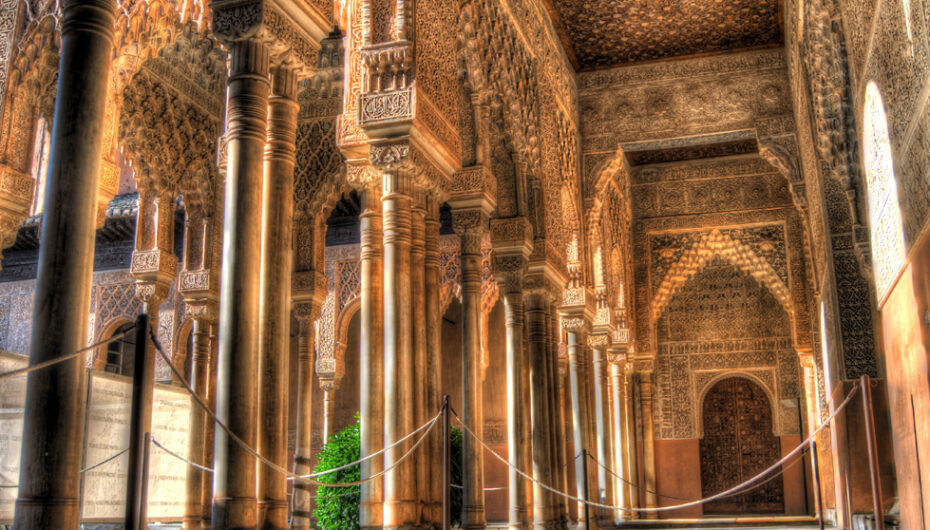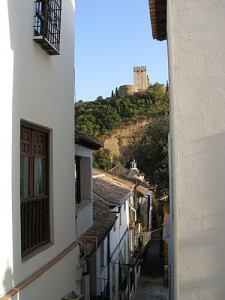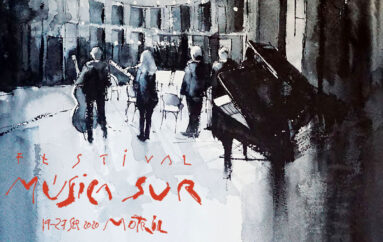
THE PALACES OF GRANADA’S ALHAMBRA REPRESENT SOME OF THE BEST ISLAMIC ART & ARCHITECTURE IN SPAIN.
The palaces of Granada’s Alhambra are some of the most impressive surviving structures from the 700 years during which Islamic forces controlled the Iberian peninsula. It represents the final flowering of Islamic art and architecture in Spain.
The Alhambra — a magnificent 14th century palace-city built by the Nasrids in the city of Granada — stands as one of the greatest monuments of Islamic Spain, or Al-Andalus. Using elaborate mosaic decoration that creates the impression of infinity, inscriptions that tell of the greatness of God, and walled gardens that symbolize Quranic paradise, the Nasrids realized a divine vision on earth. It is yours to discover.
Alhambra’s Islamic palaces, as we know them today, were built for the last Muslim emirs in Spain and the court of the Nasrid dynasty. After the conquest of Granada by the Reyes Católicos (“Catholic Monarchs”) in 1492, some portions were used by Christian rulers. The Palace of Charles V, built by Charles V, Holy Roman Emperor in 1527, was inserted in the Alhambra within the Nasrid fortifications. After being allowed to fall into disrepair for centuries, the buildings being occupied by squatters, Alhambra was rediscovered in the 19th century by European scholars and travelers, with restorations commencing. It is now one of Spain’s major tourist attractions, exhibiting the country’s most significant and well known Islamic architecture, together with 16th-century and later Christian building and garden interventions. Alhambra is a UNESCO World Heritage Site and the inspiration for many songs and stories.
More about the Alhambra here.
Albayzín
 El Albayzín is a district of Granada, in the autonomous community of Andalusia, Spain, that retains the narrow winding streets of its Medieval Moorish past. It was declared a world heritage site in 1984, along with the famous Alhambra.
El Albayzín is a district of Granada, in the autonomous community of Andalusia, Spain, that retains the narrow winding streets of its Medieval Moorish past. It was declared a world heritage site in 1984, along with the famous Alhambra.
This neighborhood had its greatest influence at the time of the Nazari. The Albaicín maintains the urban fabric of the Moorish period, with narrow streets, in an intricate network that extends from the top (St. Nicholas) through the course of the river Darro and Calle Elvira, both located in Plaza Nueva.
The traditional type of house is the carmen, consisting of a free house surrounded by a high wall that separates it from the street and includes a small orchard or garden.
Sacromonte
The Sacramonte is a neighbourhood of Granada, in Spain. It derives its name from the nearby Sacromonte Abbey, which was founded in 1600 on the hill of Valparaiso outside the old city, and is built over catacombs (originally mine workings of Roman date).
The slopes of the hill form the traditional gitano quarter of the city; and on the Sunday following 1 February each year, are also the location of the Fiesta of San Cecilio, when large crowds gather to celebrate the city’s first bishop and Granada’s patron saint, Caecilius of Elvira (San Cecilio). The fiesta and abbey act as key instruments for the preservation, propagation and dissemination of the pious legend of Saint Caecilius, by which the city of Granada in the 17th century sought to redefine its historic identity, replacing its Moorish past with fabricated (or re-discovered) accounts of Christian origins.
By the 19th century, the area had become home to a substantial Gitano community, who built their homes in caves excavated from the soft rock of the hillside. The area became famous for Flamenco music and dancing, but major floods and forced evacuations in the 1960s left the neighborhood population dramatically reduced. Since the early 1990s, however, the area has slowly become developed as a tourist attraction, and as a centre of Gitano culture.
FLAMENCO IN GRANADA
Save

 SIMOF 2024 * More Than Fashion… An Experience!
SIMOF 2024 * More Than Fashion… An Experience!
 ‘TABLAO’ with Grammy© Award-winning Cantaor ARCANGEL
‘TABLAO’ with Grammy© Award-winning Cantaor ARCANGEL
 Olga Pericet Masterclasses / Sunday, Sept., 22, 2019 * 12-4:15pm / Orange, CA
Olga Pericet Masterclasses / Sunday, Sept., 22, 2019 * 12-4:15pm / Orange, CA
 10th ‘Cumbre Flamenca’ Festival + Gracias Los Angeles!!!
10th ‘Cumbre Flamenca’ Festival + Gracias Los Angeles!!!



